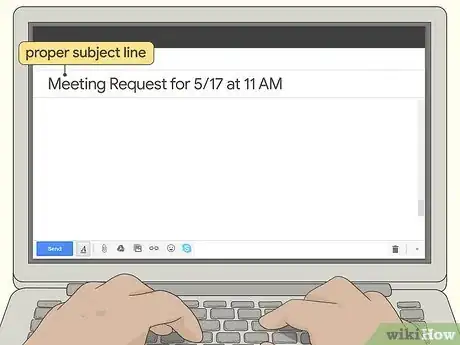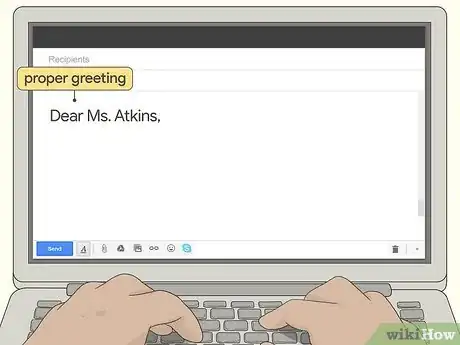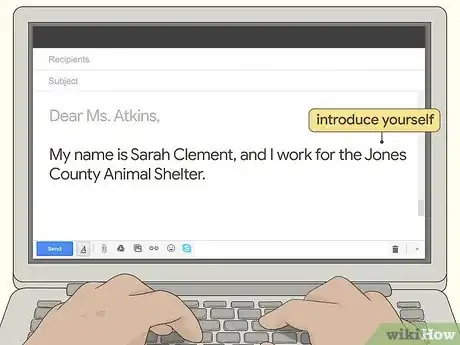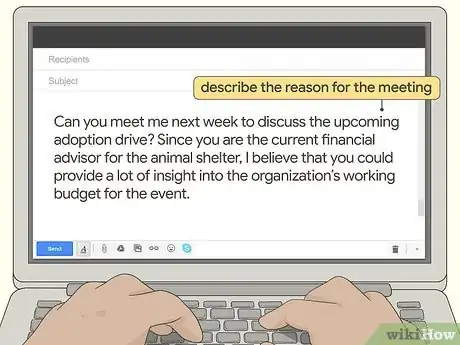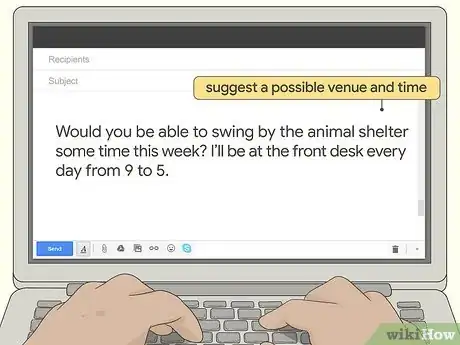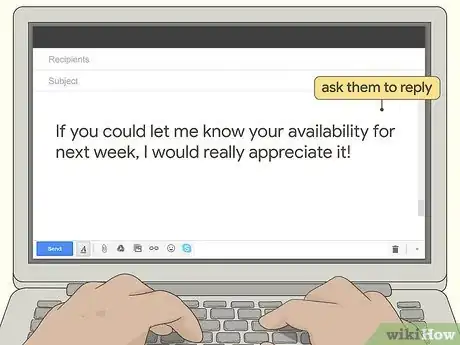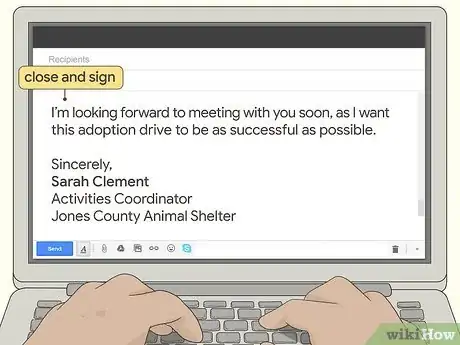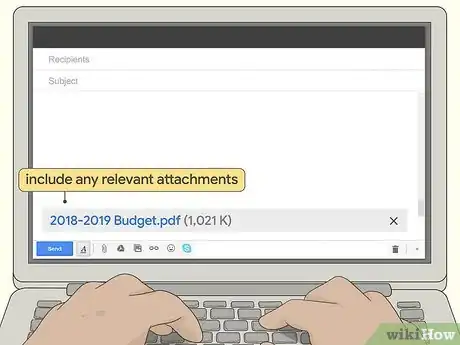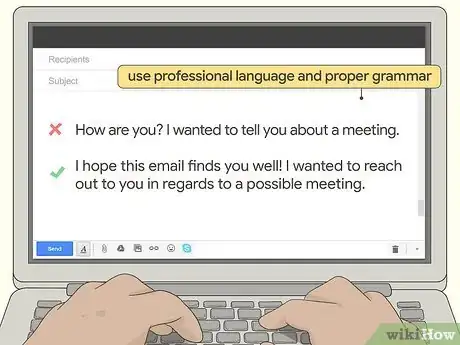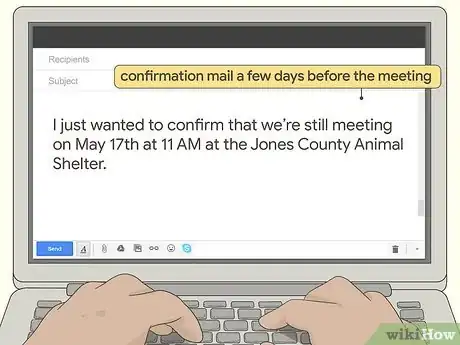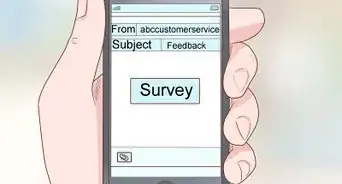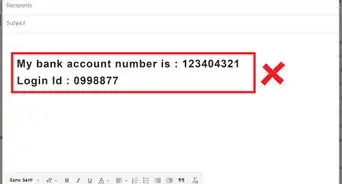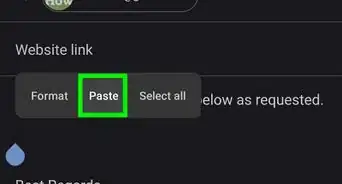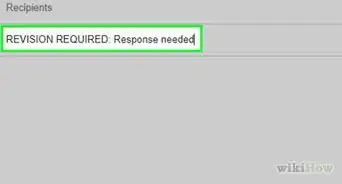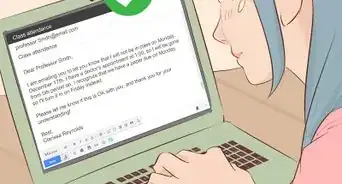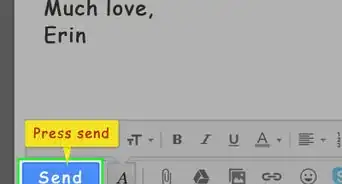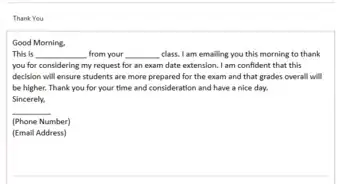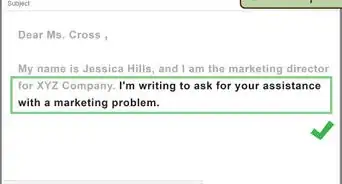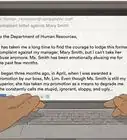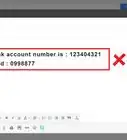This article was co-authored by wikiHow staff writer, Janice Tieperman. Janice is a professional and creative writer who has worked at wikiHow since 2019. With both a B.A. and M.A. in English from East Stroudsburg University, she has a passion for writing a wide variety of content for anyone and everyone. In her free time, you can find her working on a new crochet pattern, listening to true crime podcasts, or tackling a new creative writing project.
There are 7 references cited in this article, which can be found at the bottom of the page.
This article has been viewed 9,192 times.
Learn more...
Emails are a quick and easy way to get in touch with coworkers and other business associates, and are an effective tool for scheduling all kinds of meetings. Whether you’re trying to set an appointment with a coworker, superior, or complete stranger, you first need to format the email with a clear subject line and body text. Once you’ve signed off your email and sent the message, wait 3-5 days before sending a follow-up response.
Steps
Formatting the Email
-
1Mention in the subject line that you’d like to meet. State your purpose clearly in the subject line of the email, so the recipient knows immediately that you’d like to meet with them. Avoid using vague language like “Meeting” or “Possible Meeting Time.” Instead, use specific dates and time frames in the subject line so your recipient knows what to expect right away.[1]
- For example, type something like this: “Meeting Request for 5/17 at 11 AM.”
-
2Use a proper greeting to start off your email. Try using a standard, formal greeting when you start writing your message. If you’re reaching out to a public official or other distinguished individual that you’ve never met, use their full title in the heading. If you’re contacting a coworker or superior, use an honorific such as “Mr.,” “Mrs.,” “Mx.,” or “Miss.” As a general rule of thumb, try using greetings like “Dear,” “Hello,” and “Hi” to start off your email.[2]
- If you’re addressing a general office or group instead of an individual, use “To whom it may concern” instead.
- For example, if you were reaching out to your superior, try drafting the salutation like this:
“Dear Mr. Jackson,
I hope this email finds you well! I wanted to reach out to you in regards to a possible meeting.”
Advertisement -
3Introduce yourself if you’re meeting with a complete stranger. Dedicate your first paragraph to a brief introduction if you’re writing to a public official or other person that you’ve never met before. Focus on your name, position, and professional connection, so the recipient knows who you are and why you’re reaching out to them. If you’re contacting someone you already know, like a boss or coworker, don’t feel obligated to include an introductory paragraph.[3]
- Your introduction shouldn’t take a long time to read.
- Try writing something like this:
Dear Ms. Atkins,
My name is Sarah Clement, and I work for the Jones County Animal Shelter.
-
4Describe the reason for the meeting and its overall importance. At the beginning of the email (following your introduction, if you chose to include one), state the type of meeting you’d like to have with the recipient, and whether it will be a formal or casual affair. Once you’ve explained what the meeting is for, expand on why the meeting is important to the task that you’re trying to complete. Try to keep your explanation brief, as your recipient might not have a lot of time to go through your email.
- For instance, try writing something like this: “Can you meet me next week to discuss the upcoming adoption drive? Since you are the current financial advisor for the animal shelter, I believe that you could provide a lot of insight into the organization’s working budget for the event.”
-
5Suggest a possible venue and time for your meeting. Try thinking of a place that’s well-known and easily accessible to the recipient. If you work in the same building or general location as the person you’re emailing, see if you can meet during a lunch break. If you and the recipient don’t live or work in a nearby location, try suggesting a restaurant or other public area where you could meet. Additionally, mention a range of times that work for you, so the recipient can tell you their availability more easily.
- If you both have busy schedules, consider scheduling a phone or video conference meeting.
- For instance, draft something like this: “Would you be able to swing by the animal shelter some time this week? I’ll be at the front desk every day from 9 to 5.”
-
6Ask that the recipient replies to your message. Since you’re technically scheduling an event, politely ask that the recipient replies with their availability. If you’re contacting an especially busy individual, remember that they might take a day or 2 to respond. back.
- For example, say something like this: “If you could let me know your availability for next week, I would really appreciate it!”
-
7Use cordial closing language when ending the email. Draft a closing sentence that rehashes the purpose of your email, so the recipient clearly understands the purpose of the meeting. Use a friendly tone to sign off your email, using phrases like “Sincerely,” “Thank you,” or “Best wishes.” After writing the sign-off, leave a signature below your name, which restates your position or current career.[4]
- Cater your language to the recipient. If you’re speaking to a coworker, a sign-off like “See you soon” would make more sense than “Respectfully yours.” If you’re contacting a superior, “Sincerely” or “Best wishes” would be more appropriate than a casual sign-off like “See you.”
- For example, write something like this:
I’m looking forward to meeting with you soon, as I want this adoption drive to be as successful as possible.
Sincerely,
Sarah Clement
Activities Coordinator, Jones County Animal Shelter
-
8Include any relevant attachments that relate to the meeting. Attach any documents, spreadsheets, or other relevant files that could help prepare the recipient for the meeting. If you’re reaching out to someone regarding a complex topic, include whatever pamphlets or data sheets are needed to help the recipient understand the topic of the meeting.[5]
- For instance, if you’re discussing budget changes for an upcoming event, you might want to include a spreadsheet of the previous year’s budget.
-
9Use professional language and proper grammar throughout the email. Proofread your message for any obvious grammatical errors and spelling mistakes, so your final draft looks as polished and clean as possible. Additionally, remove any abbreviations or slang that make the message seem more casual, or more difficult to understand. If your final draft doesn’t look and sound professional, then the recipient might not take your request seriously.[6]
- While emojis can be fun to use in texts and casual emails, you shouldn’t use them to request a meeting.
Following up with the Recipient
-
1Draft a follow-up email if the recipient doesn’t get back to you in 3-5 days. Give the recipient a few days to read and reply to your request. If you don’t hear back within a business week, send the person a quick email to remind them that you’re waiting for a reply. Stress that you’re grateful for the opportunity to meet them, and that you’re thankful for their time.[7]
- Follow up calls are also an efficient way to check in with the person you’re trying to meet with.[8]
- For example, draft something like this: “I just wanted to follow up with you in regards to my meeting request. When you have a spare moment, could tell me your availability for a meeting sometime next week?”
-
2Iron out the meeting specifics in an additional email. Negotiate with other person’s schedule once they reply. Take note of the other person’s availability, and confirm a meeting time on a date when you’re both available. Try to confirm a date and time within 1-2 emails to avoid any confusion and clutter in your inbox.[9]
- Try to be as flexible as possible. If you’re reaching out to a busy person, they might not be able to meet with you right away.
- Don’t schedule a meeting at the last minute. If the recipient is busy, you might not be able to agree on a date to meet.
-
3Send a reminder or confirmation a few days before the meeting. If you’d like to be extra prepared before the scheduled meeting, try sending a confirmation email to the recipient as a reminder. Don’t make this email too long—instead, state the day, time, and place that you plan on meeting in order to double-check that the meeting is still on as scheduled.[10]
- For instance, write something like this:
I just wanted to confirm that we’re still meeting on May 17th at 11 AM at the Jones County Animal Shelter.
- For instance, write something like this:
References
- ↑ https://writingcenter.unc.edu/tips-and-tools/effective-e-mail-communication/
- ↑ https://writingcenter.unc.edu/tips-and-tools/effective-e-mail-communication/
- ↑ https://bizfluent.com/how-6742635-introduce-yourself-business-email.html
- ↑ https://bizfluent.com/list-6763994-ways-meeting-someone-via-email.html
- ↑ https://writingcenter.unc.edu/tips-and-tools/effective-e-mail-communication/
- ↑ http://www.plainenglish.co.uk/writing-business-emails.html
- ↑ https://campuspress.yale.edu/cnspy/2014/10/29/when-to-send-your-follow-up-email/
- ↑ https://bizfluent.com/list-6763994-ways-meeting-someone-via-email.html
- ↑ https://www.inc.com/geoffrey-james/how-to-ask-for-a-meeting-by-email.html
